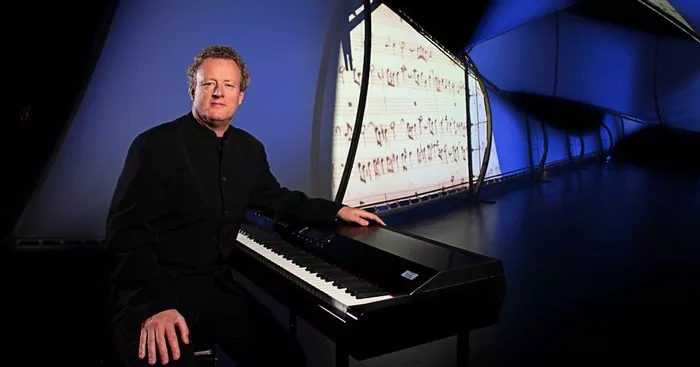In the vast tapestry of human creativity, few artistic endeavors rival the complexity and universality of music. From the ancient rhythms of tribal drums to the intricate harmonies of classical symphonies and the infectious beats of contemporary pop, music has been an integral part of human culture for millennia. But what lies beneath the surface of this enchanting art form? How does music work its magic on our minds and emotions? These questions and more are explored in Howard Goodall’s illuminating book, “How Music Works.”
Unveiling the Mechanics of Melody, Harmony, and Rhythm
Goodall, a renowned composer, conductor, and musicologist, delves deep into the inner workings of music, unraveling its mysteries with scholarly insight and a passion for the subject. The book serves as a comprehensive guide, offering readers a journey through the fundamental elements of music: melody, harmony, and rhythm.
Melody, often considered the soul of music, is examined in meticulous detail. Goodall elucidates the principles of melodic construction, from simple folk tunes to complex symphonic themes. He explores the psychology behind melodic perception, discussing why certain melodies resonate with us on a profound emotional level while others may leave us indifferent.
Harmony, the art of combining musical notes into chords and progressions, is another focal point of the book. Goodall provides a historical perspective on harmonic development, tracing its evolution from medieval chant to the rich harmonic language of the Romantic era and beyond. He demystifies chordal structures, explaining how composers use harmony to evoke specific moods and express musical ideas.
Rhythm, the heartbeat of music, receives equal attention in Goodall’s analysis. He delves into the rhythmic intricacies of various musical styles, from the syncopated rhythms of jazz to the driving pulse of rock and pop. Goodall discusses the cultural and historical influences on rhythmic patterns, highlighting how different societies have shaped and redefined rhythmic conventions over time.
The Power of Musical Form and Structure
Beyond the elemental components of melody, harmony, and rhythm, Goodall delves into the broader concepts of musical form and structure. He examines the architectural frameworks that give shape to musical compositions, from sonata form in classical music to the verse-chorus structure in popular songs.
Goodall’s exploration of musical form extends to the realm of improvisation and variation. He discusses how musicians across genres use improvisational techniques to create spontaneous musical expressions, as well as the art of variation, where composers transform and develop musical themes throughout a piece.
The book also delves into the role of technology in shaping musical composition and production. Goodall traces the evolution of recording technology and its impact on the creation and dissemination of music, from the early days of analog recording to the digital revolution of the 21st century. He discusses how advancements in recording and editing tools have influenced musical styles and techniques, opening new avenues for artistic experimentation.
Cultural Context and Global Perspectives
One of the strengths of “How Music Works” is its exploration of music within cultural and historical contexts. Goodall takes readers on a global journey, examining the diverse musical traditions of different societies and civilizations. From the intricate ragas of Indian classical music to the rhythmic polyphony of African drumming, Goodall celebrates the richness and diversity of human musical expression.
He also discusses the socio-political dimensions of music, highlighting how music has been used as a tool for social change, cultural preservation, and political expression throughout history. Goodall’s insights shed light on the interconnectedness of music and society, showcasing the profound impact that music can have on individuals and communities.
Educational Value and Practical Applications
In addition to its scholarly depth, “How Music Works” offers practical value for musicians, educators, and music enthusiasts alike. Goodall provides exercises and examples that allow readers to apply the concepts discussed in the book, fostering a deeper understanding of musical theory and practice.
For aspiring composers and songwriters, the book offers valuable insights into the creative process, encouraging experimentation and innovation. Goodall emphasizes the importance of listening critically to music across genres, urging readers to explore diverse musical styles and draw inspiration from a wide range of sources.
Educators will find “How Music Works” to be a valuable resource for teaching music theory and appreciation. Goodall’s clear explanations and engaging writing style make complex musical concepts accessible to students of all levels, from beginners to advanced musicians.
A Testament to the Universality of Music
In “How Music Works,” Howard Goodall celebrates the universality of music as a language that transcends cultural boundaries and speaks to the human experience. Whether exploring the intricate harmonies of a Bach fugue or the infectious rhythms of a Latin dance groove, Goodall invites readers on a captivating journey through the captivating world of music.
The book serves as a testament to the enduring power of music to inspire, uplift, and connect us in ways that words alone cannot. Through his comprehensive exploration of musical theory, history, and practice, Goodall deepens our appreciation for the art form that enriches our lives and touches our souls.
Conclusion
In conclusion, Howard Goodall’s “How Music Works” stands as a must-read for anyone passionate about music and curious about its inner workings. With its scholarly depth, engaging prose, and practical insights, the book offers a treasure trove of knowledge and inspiration for musicians, educators, and enthusiasts alike. Whether you’re a seasoned musician seeking to deepen your understanding of musical theory or a curious listener eager to explore the magic of music, Goodall’s book is sure to enlighten and delight. Dive into “How Music Works” and embark on a fascinating journey through the heart and soul of musical creativity.
Related topics:



























